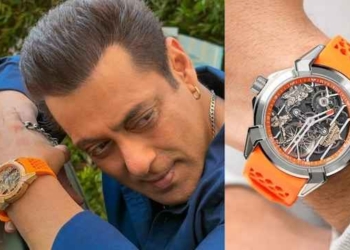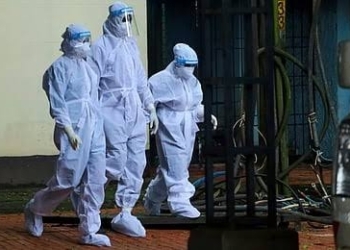Rajasthan News Desk !!! The nine days of Navratri are considered auspicious for the worship of Maa Durga. During this time, from Maa Shailputri to Siddhidatri Mata, all are worshipped. It concludes with havan and immersion on the day of Durga Navami. According to Devi Bhagwat Purana, there are 51 Shaktipeeths of Maa Durga. During Navratri, there is a rush of devotees to visit the Shaktipeeths established in India. Let us know about the 9 Shaktipeeths of Maa Durga and the mythological story associated with them.
Story related to Shakti Peeth
The story related to Mata Shakti Peeth is also described in the Puranas. According to the legend, Lord Shiva started performing Tandava on the earth with the dead body of Sati, daughter of Daksha Prajapati. Then Lord Vishnu cut Sati’s dead body into pieces with Sudarshan Chakra to calm Shiva’s anger. In this sequence, wherever Sati’s body parts and ornaments fell, those places came to be known as Shakti Peeth.
9 major Shakti Peethas of Maa Durga
1. Kalighat Temple Kolkata – four fingers fell 2. Kolhapur Mahalakshmi Temple – third eye fell 3. Ambaji Temple Gujarat – heart fell 4. Naina Devi Temple – eyes fell 5. Kamakhya Devi Temple – private parts fell here 6. Harsiddhi Mata Temple Ujjain – left hand and lips fell here 7. Jwala Devi Temple – Sati’s tongue fell 8. Mother’s left toe fell at Kalighat 9. Varanasi – Mother Vishalakshi’s bead earring fell at Manikarnik Ghat in Kashi, Uttar Pradesh.
Amar Ujala is showing you nine temples of Goddess Durga in Rajasthan – from Shaktipeeths to the Goddess who takes a bath in fire and the Mother of Rats.
1. Tripura Sundari Shaktipeeth Temple, Banswara
The Shaktipeeth temple of Siddha Mata Shri Tripur Sundari is one of the 52 Shaktipeeths in Banswara, a tribal dominated district of southern Rajasthan. It is believed that the goddess fulfils the wishes made in the temple, this is the reason why people from common people to leaders visit the court of the mother and mark their presence.
There is a grand temple of Mata Tripura Sundari in the middle of the Aravalli mountain ranges in Talwara village, 18 km from Banswara district. The doors of the main temple are made of silver. The idol of Mother Bhagwati Tripura Sundari has 18 arms. The idol has replicas of 9 forms of Goddess Durga. Mother is sitting on lion, peacock and lotus seat. During Navratri, a huge crowd of devotees gathers in the Tripura Sundari temple, which creates a fair like atmosphere.
Even PM, CM attend
Prime Minister Narendra Modi, former Prime Minister Atal Bihari Vajpayee, former President Pratibha Patil, Union Home Minister Amit Shah, former CM Haridev Joshi, CM Ashok Gehlot, former CM Vasundhara Raje and many other leaders, MPs, MLAs, ministers visited the temple. Election rallies in Banswara are started after the leaders visit the temple of Mata.
The rulers of Gujarat, Malwa and Marwar were worshippers of Tripura Sundari Shaktipeeth
In the northern part of this temple, there is a Shivalinga from the time of Emperor Kanishka. It is believed that this place must have been famous since the pre-Kanishka period. At the same time, some scholars believe that the existence of Devi Maa’s Shaktipeeth here was before the third century. They say that earlier there was a historical city named ‘Garhpoli’ here. ‘Garhpoli’ means Durgapur. It is believed that the rulers of Gujarat, Malwa and Marwar were worshippers of Tripura Sundari.
Chaitra Navratri 2023 Rajasthan Famous Mother Temple Tripura Sundari Shaktipeeth
2. Kaila Devi Temple, Shaktipeeth, Karauli
Kaila Devi Temple in Karauli district is a hundred years old temple. This ancient temple has two idols under golden umbrellas on a silver pedestal. One is on the left, her mouth is slightly crooked, i.e. Kaila Maiya, the other is the image of Mata Chamunda Devi on the right. Kaila Devi has eight arms. This temple is famous as the main Shaktipeeth of North India. Many stories related to this temple are prevalent here.
It is believed that the daughter Yogmaya whom Kansa wanted to kill by imprisoning Lord Krishna’s father Vasudev and Devaki, is seated in this temple in the form of Yogmaya Kaila Devi. The Kalisil river located near the temple is also called a miraculous river. Kaila Devi temple is 30 km from Karauli district and 56 km from Hindaun railway station. During Navratri, devotees from far and wide come here to visit the temple of Mata.
3. Shri Karni Mata Temple, Deshnok, Bikaner
There is a famous temple of Karni Mata in Deshnok, Bikaner in western Rajasthan. A large number of rats live in this temple, so it is also called Chut Wali Mata Ka Mandir or Chut Wala Mandir. It is believed that some of these rats are also white. The sight of white rats in the temple is considered very auspicious. It is considered a miracle of the goddess that despite the presence of so many rats, no disease has spread here till date. On Navratri, a large number of devotees reach here for darshan and to fulfill their wishes. Deshnok Karni Mata Temple is probably the only temple in the country where about 20 thousand rats also live. White rats are considered to be the carriers of Mother Karni.
Maa Karni is the family deity of Bikaner royal family
Karni Mata is the goddess of the Bikaner royal family. The present temple of Karni Mata was built by Maharaja Ganga Singh of Bikaner state. Apart from the rats, the main attractions of this temple are the excellent work done on the marble main gate, the large silver door on the main gate, the golden umbrella of the mother and the huge silver plate kept for the rats’ offerings. Devotees believe that Karni Devi was an incarnation of Mother Jagadamba.
At the place where this magnificent temple is situated, about 650 years ago, the mother had worshipped her deity by staying in a cave. This cave is still located in the temple premises. When the mother died, her idol was installed in this cave as per her wish. It is said that the states of Bikaner and Jodhpur were established with the blessings of Maa Karni. This famous temple is about 30 km from Bikaner railway station. It can be easily reached by road and rail.
4. Shri Shila Mata Temple, Amer
Shila Mata, the goddess worshipped by the Kachwaha dynasty of the royal family of Jaipur, is the main Shaktipeeth of the people of Jaipur after independence. This temple is very glorious and is also said to be miraculous. It is also famous among the practitioners of Tantra and Sadhakas. Before the establishment of Jaipur, there was Amer princely state, where the illustrious ruler Raja Mansingh I won more than 80 wars as the chief commander of the Mughal ruler Akbar with the blessings of Shila Mata. Before independence, only the members of the royal family and the prominent feudal lords could visit the Shila Mata temple located in the Amer palace complex, now hundreds of devotees visit the Mata every day.
Long queues are seen for the darshan of Mata during Navratri and a fair is held on the day of Chhath. This Shaktipeeth, one of the ancient major temples of Jaipur, was established in the fifteenth century by Raja Mansingh I, the then ruler of Amer. The main gate of the temple is made of silver. Navdurga Shailputri, Brahmacharini, Chandraghanta, Kushmanda, Skandamata, Katyayani, Kalratri, Mahagauri and Siddhidatri are inscribed on it. Kali, Tara, Shodashi, Bhuneshwari, Chhinnamasta, Tripura, Bhairavi, Dhumavati, Bagulamukhi, Matangi and Kamala are depicted as the ten Mahavidyas. There is a red stone idol of Ganesha above the door. A silver Naggar is kept in front of the door. Near the entrance, there are carved figures of Mahalakshmi on the right and Mahakali on the left.
She was called Shiladevi because she was found in the form of a rock.
There is a religious belief that the image of Shila Mata was found in the form of a rock. In 1580 AD, the ruler of Amer, Raja Mansingh, brought this stone from there to Amer after his victory over the Jasore Empire of Bengal. Here, Mahishasur was carved in the form of Mata by prominent artists. A saying is also very popular in Jaipur about this – Tell Sanganer to father Hanuman to Jaipur, Shila Devi is the king of Amer.
5. Shri Chamunda Mata Temple, Mehrangarh, Jodhpur
Chamunda Mata Temple in Jodhpur is the temple of the royal family’s presiding deity. It is located in the southern part of the Mehrangarh Fort. Rao Jodha, the founder of Jodhpur city, bought an idol of his beloved goddess Chamunda from the old capital of Mandore in 1460. He installed the idol of Chamunda Devi in the Mehrangarh Fort and Chamunda became the presiding deity ever since. During Dussehra, the fort is filled with people and devotees who are worshipped by people from outside and inside Jodhpur city.
Goddess Chamunda is the main deity of Rajputs
Located in Jodhpur’s Mehrangarh Fort, this temple was built by Rao Jodha when he was building the fort. The hill on which he chose to build this fort was occupied by Harmeet Bhatt. When he was evicted from there, he cursed the king that there would always be a shortage of water in his fort. The saint built the temple of Chamunda Mata inside the fort to escape this curse and save the people from it and since then Goddess Chamunda has been the main deity of the Rajputs.
6. Shri Jeen Mata Temple, Sikar
The Jeen Mata Mandir located in Sikar district of Shekhawati region is a very famous temple among the people. A very big fair is held here during Navratri. The very ancient temple of Maa in Jeenmata village on Sikar-Jaipur road in Shekhawati region is the main center of faith of the devotees. This temple is not only built in the middle of a beautiful forest but is also situated between three small hills. Jain Mata Mandir, one of the ancient Shaktipeeths of the country, is south facing. There are statues of Tantrikas on the walls of the temple which shows that it must have been the center of worship of Tantrikas. There is an octagonal statue of Jain Bhagwati inside the temple. The pavilion built under the mountain is called a cave.
According to beliefs, Jeen Mata was born in a royal family of Ghanghu village of Churu, Rajasthan. She is considered to be the incarnation of Maa Shakti and her elder brother Harsh is said to be the incarnation of Lord Shiva. According to the stories, once there was a dispute between the two siblings and Mata came to this place and started doing penance.
Worried about his sister’s defeat, brother Harsh also followed her here and tried his best to convince his sister, but he was disappointed. After which he also started penance at a nearby place. At this place, there is a temple of Harshnath among the hills of Aparavali. When the army of Mughal emperor Aurangzeb started demolishing the temples of Shekhawati, people prayed to Mata Jhinmata.
With her miracle, Maa released a huge army of bees on Aurangzeb’s army. It is believed that when Aurangzeb’s soldiers ran away bleeding, Aurangzeb apologized to Maa and promised to send oil for the eternal lamp in the temple. After which, oil for the lamp was arranged from Delhi and then Jaipur. After this miracle, Jinmata came to be known as the Goddess of Bees.
7. Arbuda Devi Temple, Shaktipeeth, Mount Abu
Arbuda Devi Temple is located in Mount Abu, Rajasthan. Arbuda Devi Temple is known as Adhar Devi Shaktipeeth. This temple is 3 km away from Mount Abu, Rajasthan. It is situated on a hill. It is believed that the lips of Goddess Parvati fell here, so Shaktipeeth was established here. Here Mother Arbuda Devi is worshiped as Mother Katyayani Devi, because Arbuda Devi is said to be the form of Mother Katyayani. There is a crowd of devotees here throughout the year, but during Navratri, a flood of devotees pours in here.
One attains salvation by seeing the Goddess and her Paduka
It is said that the devotees get salvation just by seeing the goddess here. Devotees travel hundreds of meters and climb about 350 stairs to see the mother here. This temple is located in a natural cave. A lamp burns continuously inside the cave and Bhagwati is seen by its light. The temple was established 5 and a half thousand years ago. It is believed that by just seeing the mother, a person gets freedom from all sorrows and devotees get salvation. The Charan Paduka temple of Arbuda Devi is also located in the temple. She killed a demon named Baskali under the Charan Paduka of the mother. The story of Mother Katyayani killing Baskali is found in the Puranas.
8. Edana Mata Temple, Udaipur
In Idana Mata Temple, one of the most prominent Shaktipeeths of glorious Mewar of Rajasthan, the mother herself takes a fire bath when she is pleased. This temple is located among the huge Aravalli hills on the Kurabad-Bambora road, 60 km from Udaipur city. Idana Mata is the revered mother of the entire Mewar including Rajput society, Bhil tribal society. It is believed that this temple was built during the Mahabharata period. This temple, which contains many mysteries, is crowded with devotees during Navratri.
My mother mysteriously bathes herself in fire
Every year a large number of devotees come here to see the Agni Snaan of Idana Mata. Devotees wait for hours to get a glimpse of the Agni Snaan. It is believed that at this time the devotees receive the blessings of the goddess. In ancient times, the kings here have been worshiping Idana Mata as their goddess. Devotees and tourists come here from far and wide for darshan.
9. Shri Krishnai Annapurna Mataji Temple, Baran
This temple is on the hill of Ramgarh, about 40 km from Baran. The big crater of the famous Ramgarh Crater is also near it, which was once formed by the fall of a meteorite. To visit the temple, one has to climb 900 stairs, which are winding. Which is situated on a hill at a height of 1000 feet from the ground level. It is believed that the mother herself appeared from a cave. Here Maa Durga is in the form of a girl. Kanya Pujan or Kanjke Pujan is considered very important in Navratri. This temple was built after the war between Jaipur and Kota princely states. On Navratri, people are coming from far and wide to visit the temple.










